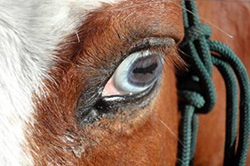|
Did you have a recent visit where you received printed instructions on how to administer treatments but now you cannot find it? It is time to do a treatment but you don't remember how to do it? The brief summaries below will help you to re-address the most common issues horse owners face when they have to administer treatments themselves without the watchful eye of their veterinarian.
 How to administer eye medications How to administer eye medications
First wipe off the eye with a clean cloth or towel to remove any mucous or debris. If you have both eye ointment and eye drops, always give the ointment last and preferably 20 minutes after the drops. Next, gently pull the eyelids apart using your thumb and forefinger of one hand. Brace the hand with the medication against the face of the horse to prevent poking the eye if the horse moves its head. Squeeze or drop the medication on the 3rd eyelid. Do not touch the end of the medication tube to the eye. If your horse won’t stand still for treatments, get help. It is extremely important that medications be delivered completely and timely (including throughout the night, if necessary).
 Colic aftercare Colic aftercare
If your horse had a colic episode, and received mineral oil through a nasogastric tube, please follow these instructions: Watch for the shiny appearance of oil in the manure, and also around the tail. The oil usually takes approximately 12 hours to pass through the GI tract. If the horse is comfortable and passing manure then feed only a handful of hay every few hours for the next 24 hours. You may offer a bran mash once or twice daily made from wheat bran and mixed well with warm water until it is of a thin oatmeal consistency. Offer lukewarm water for drinking. Monitor water intake for the next 24 hours. Your horse should be drinking 7-15 gallons daily for an average sized (1000 lb) horse. Monitor fecal output: an adult size horse should pass 5-10 formed piles within the next 24 hours. You may periodically check for sand in your horse by using a clear plastic bag and placing a piece of feces in it with water. In time the sand will float to the bottom of the bag. It is essential that the feces has not touched the ground in order for the test to be accurate.
Change compression bandage on a leg
You should monitor the bandage often for slipping or for any swelling above it. Do not apply topical medications unless directed. To place a compression bandage:
- Apply a topical ointment (that was prescribed during your visit) to the wound.
- Place a Telfa pad over the wound (shiny surface facing the wound) and secure in place with a soft white gauze roll.
- Place the large white combine padding over this wrap.
- Secure in place with brown gauze - this can be applied tightly. **Make sure that there is still some white bandage sticking out on the top and the bottom.
- Apply vet wrap in the same direction as the brown gauze.
- Secure the bandage top and bottom with Elasticon (sticky beige bandage).
Watch for increase in lameness, increased heat, pain or swelling of the area, purulent (thick, creamy) discharge from the wound and bad odor. You should also know that the highest risk for wound breakdown is 5-7 days. Please call immediately if the wound re-opens.
How to apply a hoof bandage:
- Ensure that the horse is confined to a dry living area.
- Thoroughly clean the foot to remove all manure, rocks, and debris.
- Apply topical treatment to the affected area as directed. Place white 4x4 gauze on the affected area.
- Secure the gauze with a soft white gauze roll, wrapping it around the hoof.
- Cover the bottom of the hoof with combine roll, or alternatively, baby diapers also work very well.
- Wrap brown gauze tightly over the padding, leaving some white padding showing at the top of the bandage.
- Wrap the foot with vetwrap, also leaving some white padding showing at the top.
- Place a duct tape patch on the bottom of the foot and further secure the patch with duct tape around the hoof.
- Secure the bandage top with Elasticon (sticky beige bandage).
How to administer intramuscular medications
Giving large amount of medications into the muscle of a horse can be a daunting task, but most horses tolerate it very well. If you have to give the same medication multiple times a day, rotate the sites of injection. The pectoral (chest) muscle, the neck and the rump (semimembranosus muscle, just inside the thigh) are used to give injections. When you give an injection in the neck, always give it in the middle of the triangle lined by the shoulder blade, the vertebral column in the neck (on the bottom) and the nuchal ligament (crest of the neck, on the top). When you give an injection in the rump, avoid the large crease between the two large muscles of the thigh, where a large nerve is located. If you have more than 20 mL injection to give, inject 20 mL into the muscle, then pull out the needle a little bit (but don't come out of the skin) and redirect in the muscle, push the needle in again and inject the rest of the injection. You should always aspirate (pull back) after placing the needle into the muscle to check if there is any blood. Pull out and redirect if you see blood. NOTE: This is especially important when you are injecting penicillin due to severe reactions that might occur.
How to disconnect an intravenous fluid line
If your horse received intravenous fluid treatment at home, you should shut off or completely disconnect the fluid line from the catheter after the treatment is done. Always watch for the levels of fluids in the bags, and shut off the line at the time when the fluids run out.
- First, slide the small plastic lock to occlude or block the tubing on the catheter extension set, and also lock the fluid line with the large plastic lock located on the coiled tubing.
- Disconnect the fluid line from the extension set, and place a needle with cap at the end of the fluid line. This is needed to save the fluid line and keep the end sterile, just in case we have to place the horse back on fluids. Place the infusion plug (small green plug) into the end of the catheter/extension set.
- Flush the catheter with 1-2 mL heparinized saline solution. To do this, open the plastic lock on the catheter extension set, flush, and then close the lock again.
|





